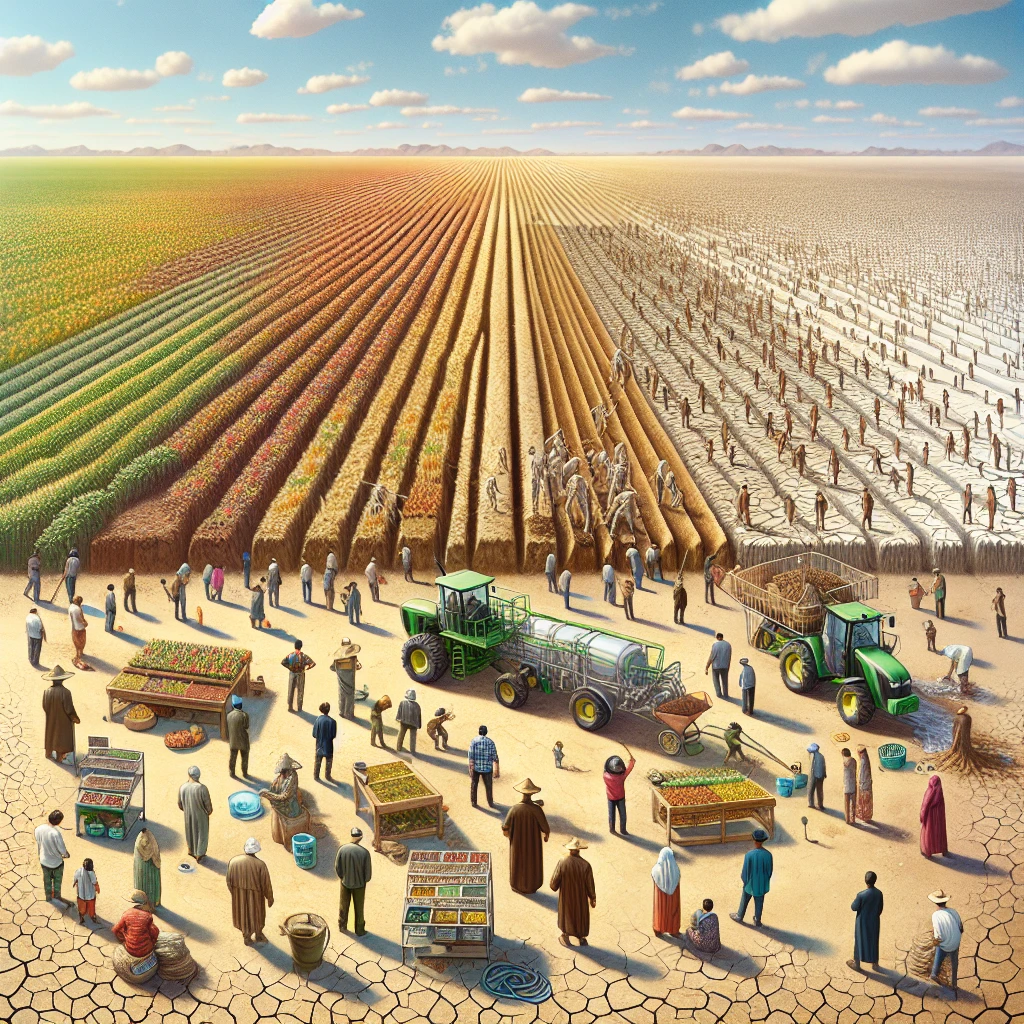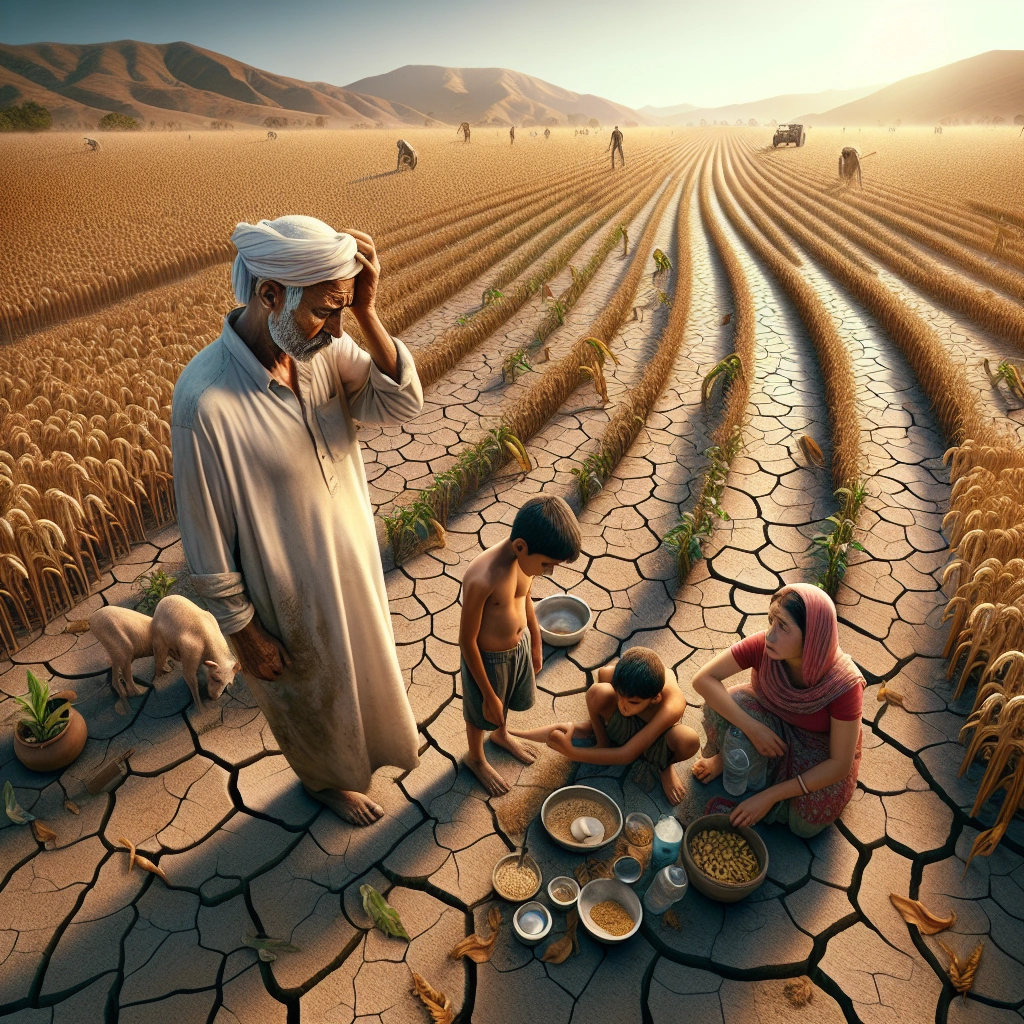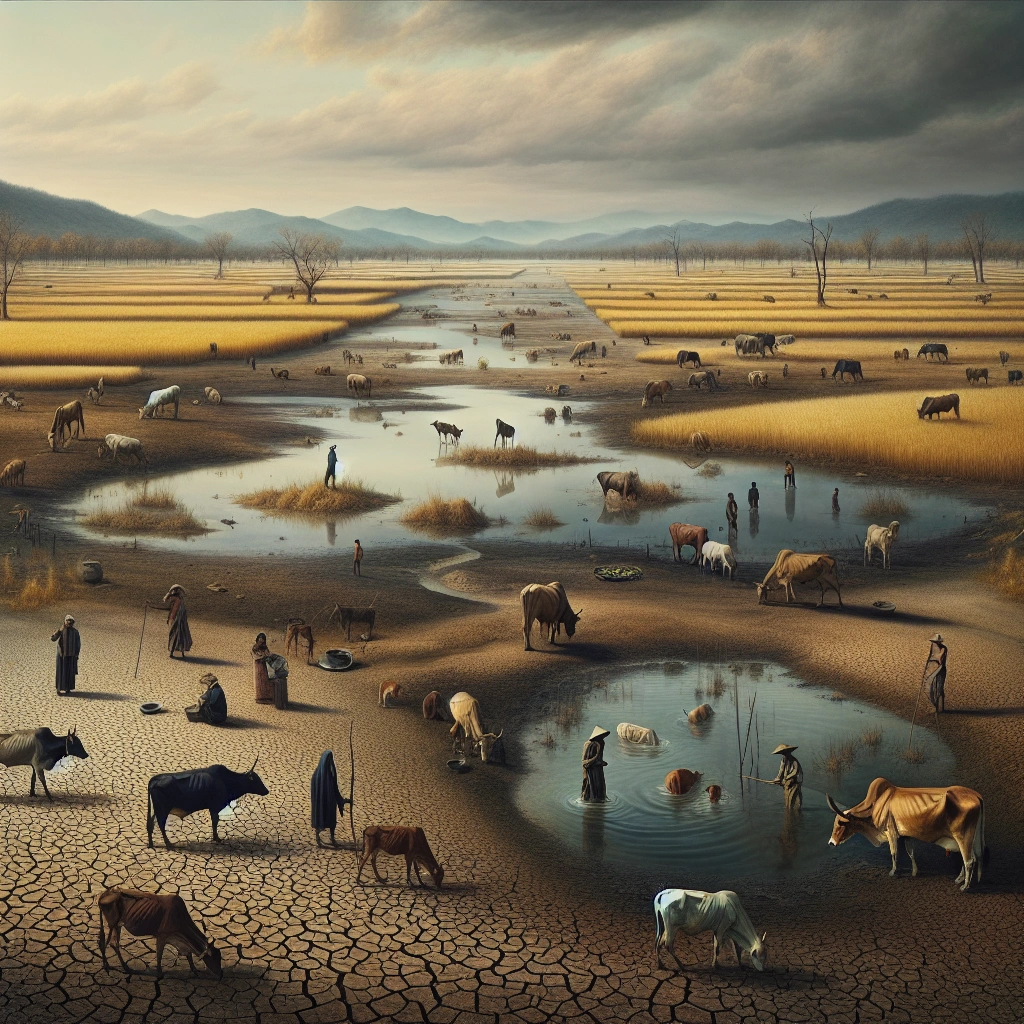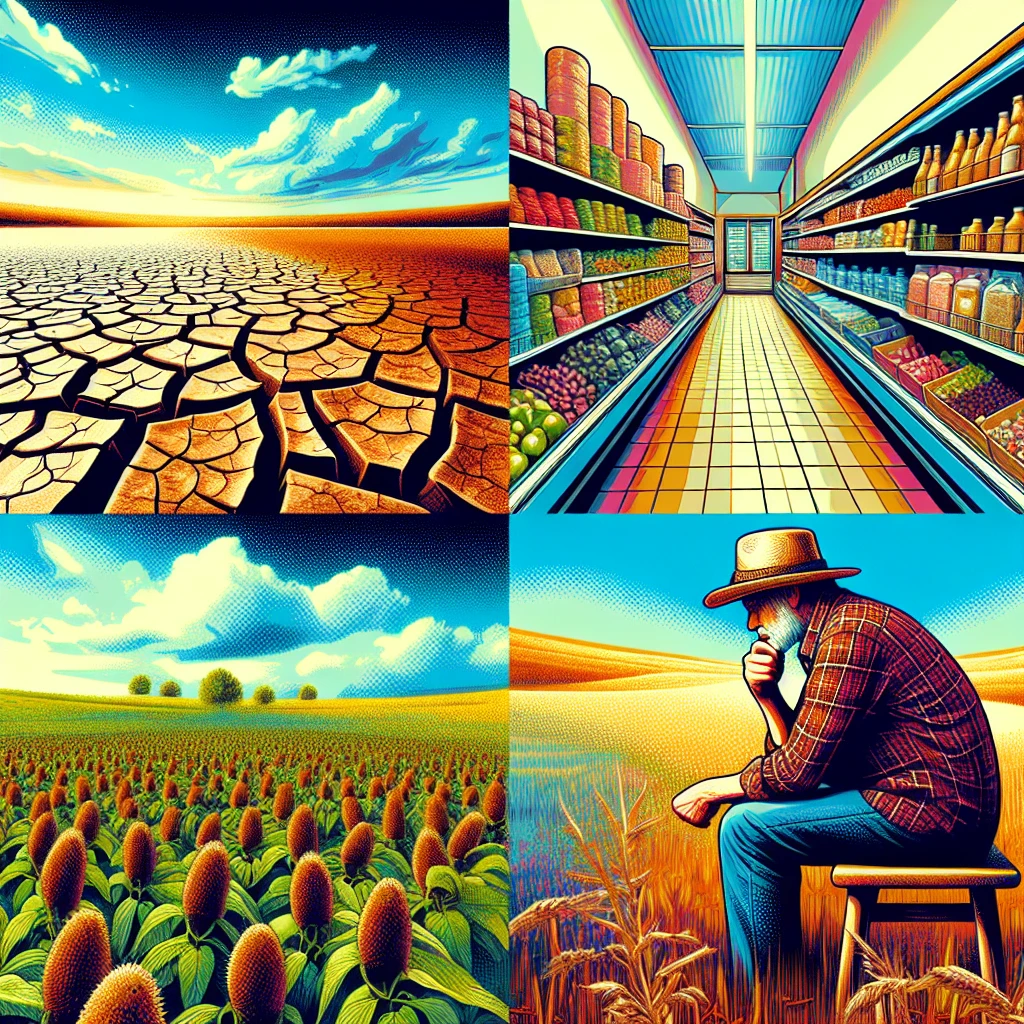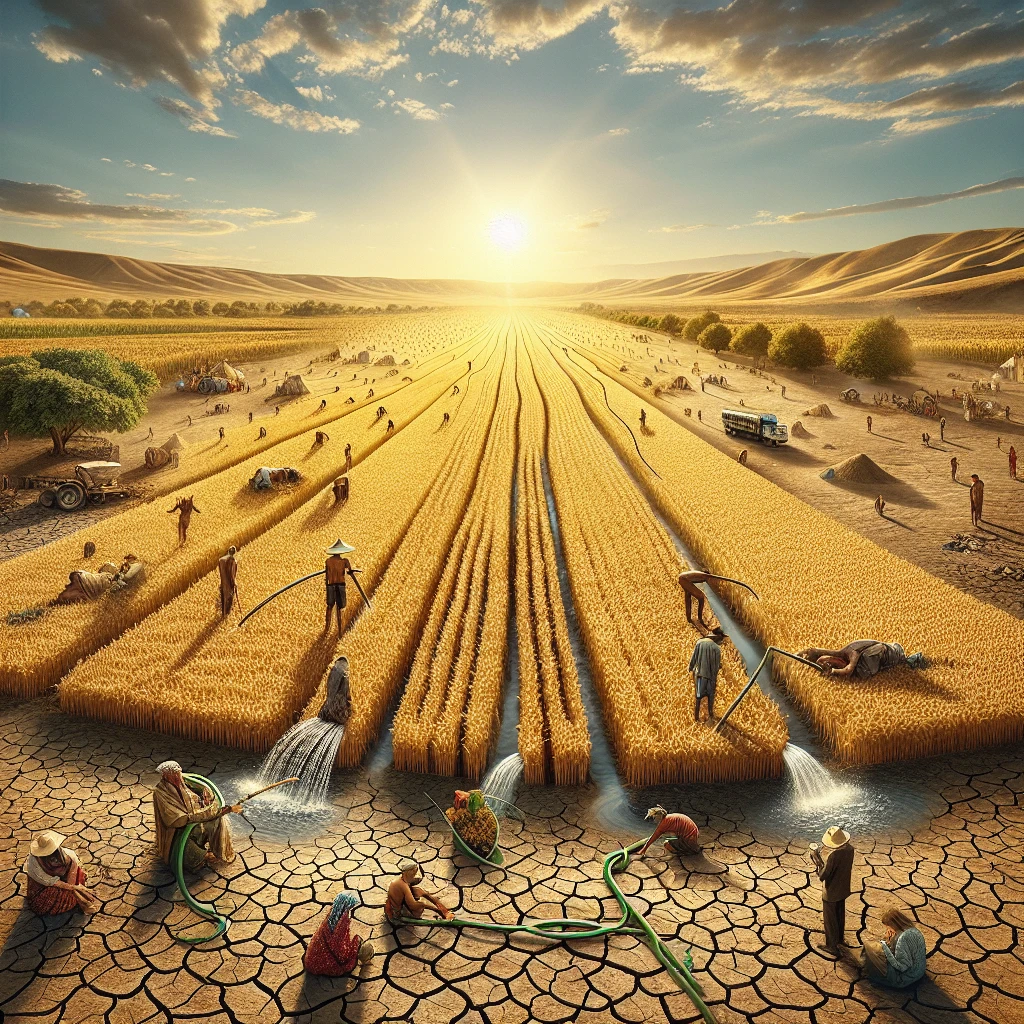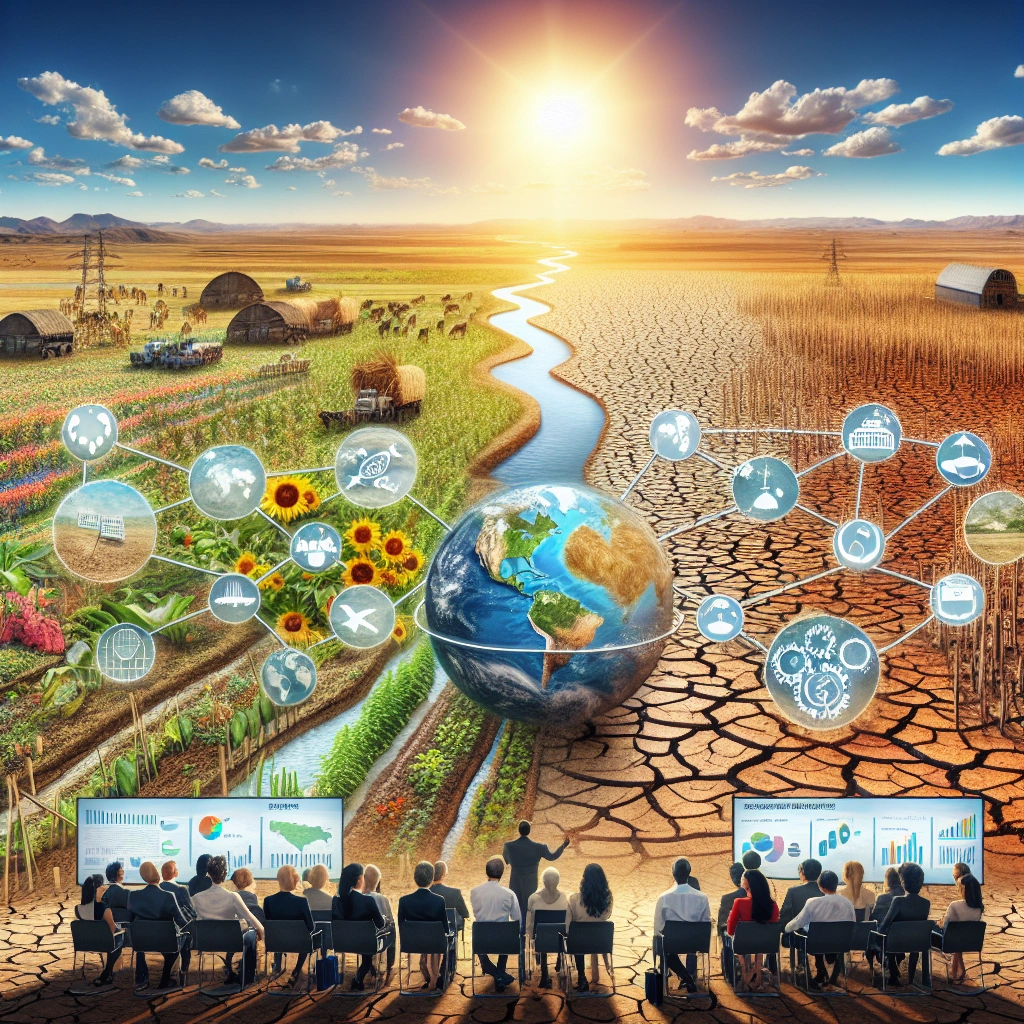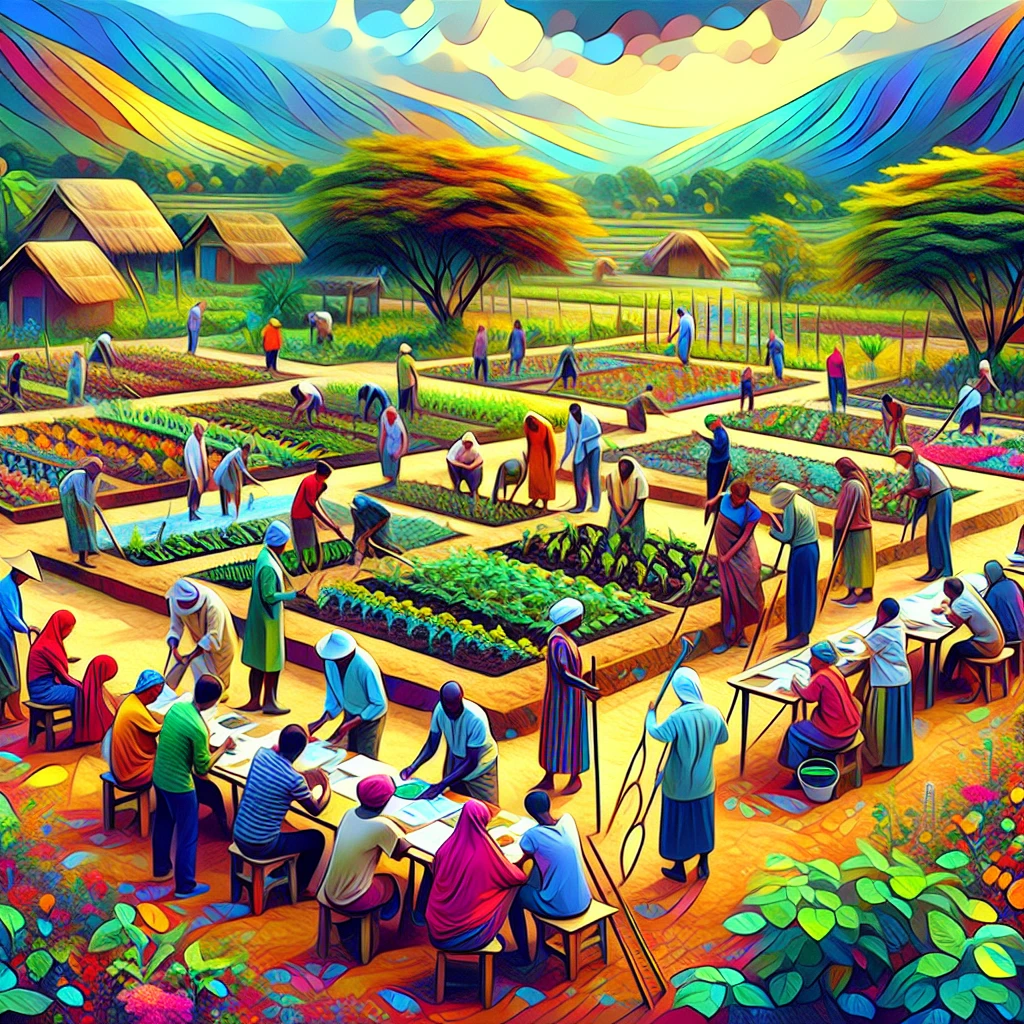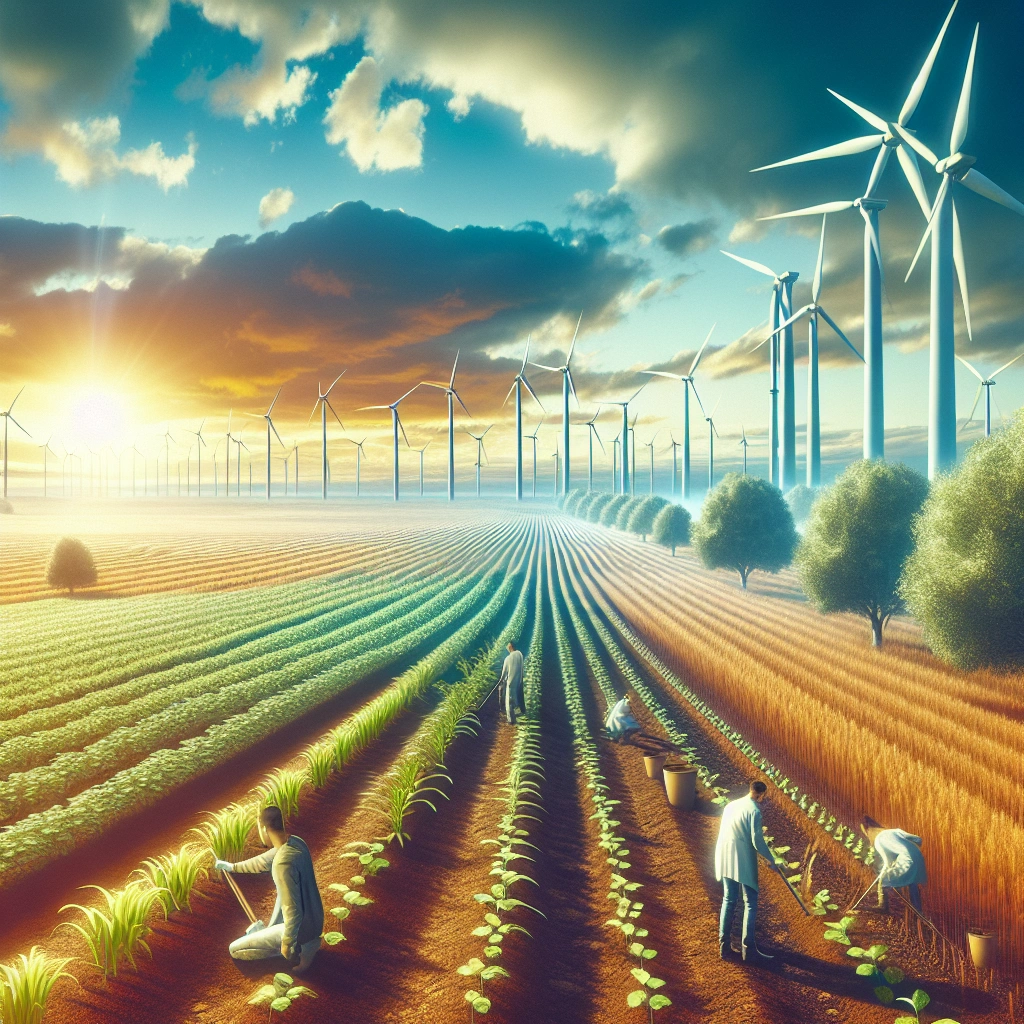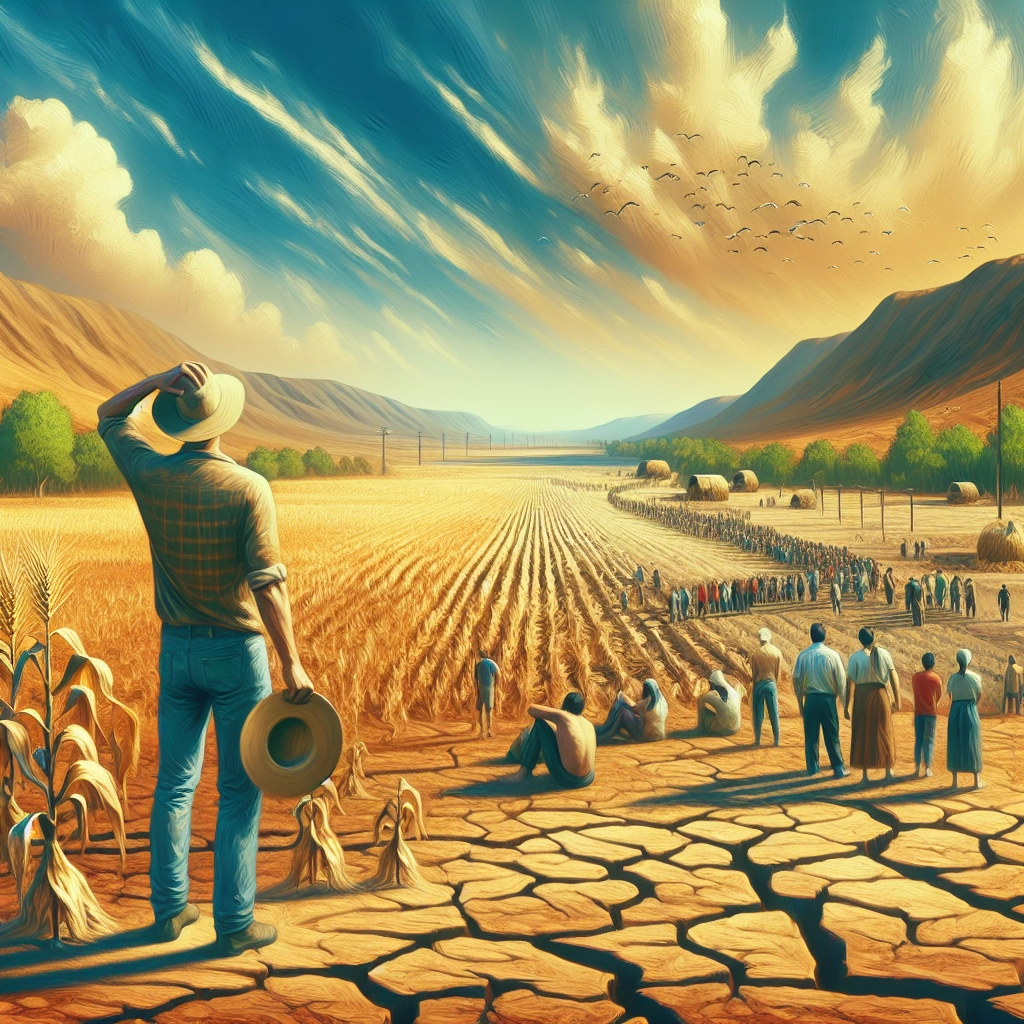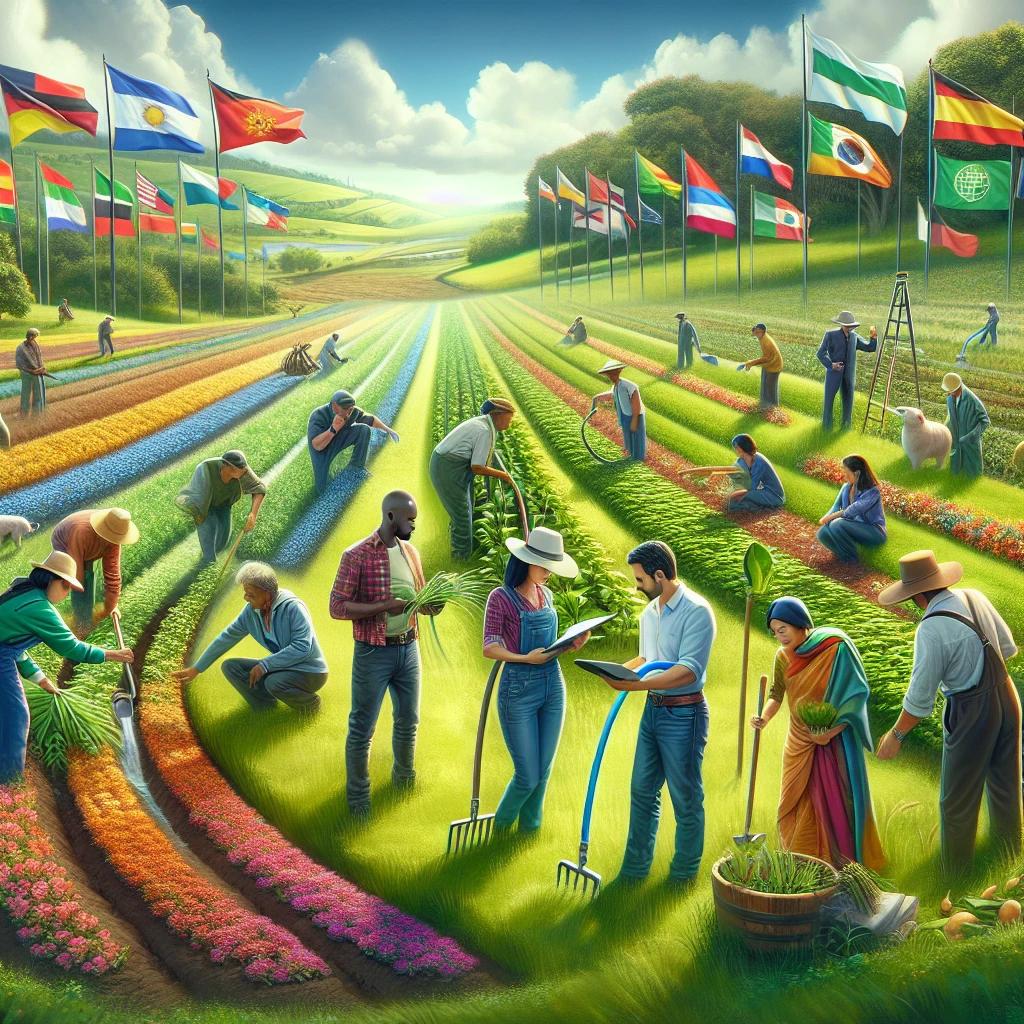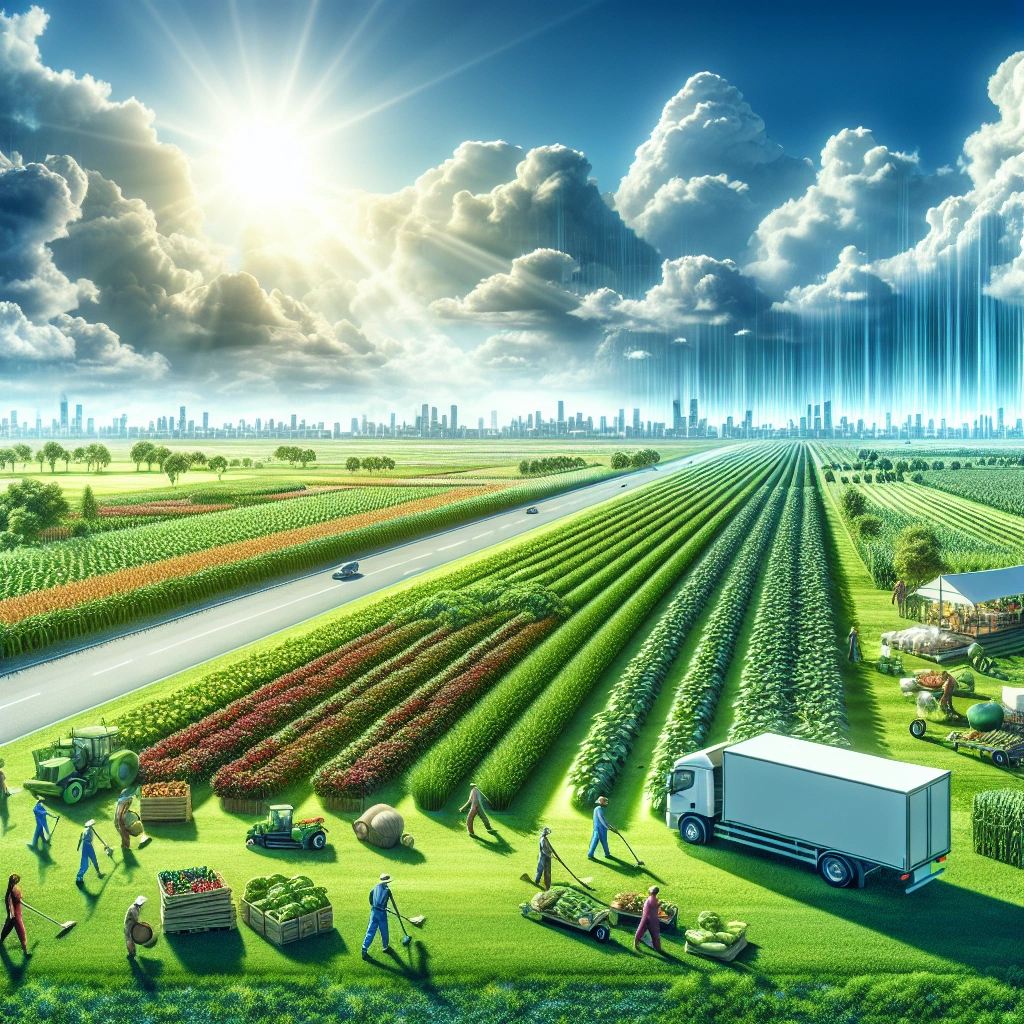

Climate change refers to long-term shifts in temperatures and weather patterns, which have a broad range of observed effects on food production and security. These effects include changes in precipitation patterns, more frequent extreme weather events, and shifts in temperature, which can impact crop yields and food availability.
Climate change is likely to diminish continued progress on global food security through production disruptions that lead to local availability limitations and price increases, interrupted transport conduits, and diminished food safety, among other causes. Additionally, heavy rainfalls can lead to more soil erosion, which is a major environmental threat to sustainable crop production, while droughts can also have a significant impact on agricultural production.
Increased climate variability has been found to have an impact on food safety, particularly on the incidence and prevalence of food-borne diseases. These projected effects of climate change on food production and security highlight the urgent need to analyze and address the impacts of climate change on the world’s food systems.
Check out this Youtube video: “Climate Change Could Affect Global Agriculture Within 10 Years” to gain insight into the projected effects of climate change on food production and security.
The Current State of Food Production and Security
Overview of the current global food production and security situation
The global production of primary crops has significantly increased over the past two decades, with a 54 percent growth from 2000 to 2021, reaching 9.5 billion tonnes in 2021. This substantial growth is primarily attributed to the rapid rise in crop yields, resulting in a diverse range of diets in many countries. However, this escalated production has also led to challenges such as overconsumption, contributing to greenhouse gas emissions, water scarcity, and biodiversity issues.
| Key Points |
|---|
| Global agricultural production of primary crops grew by 54 percent from 2000 to 2021, reaching 9.5 billion tonnes in 2021. |
| Rapid rise in crop yields has led to diverse diets in many countries. |
| Challenges include overconsumption, greenhouse gas emissions, water scarcity, and biodiversity issues. |
Challenges and concerns in the current system
The current global food system faces dual challenges of increasing food demand while competing for vital resources like land and water. Furthermore, food production contributes significantly to greenhouse gas emissions, water scarcity, and wider biodiversity issues, posing a threat to food security.
Climate change is also a major concern, impacting food production through increased frequency of storms, droughts, and extreme weather events. It’s crucial to address these challenges to ensure sustainable food production and secure global food systems for future generations.
The surge in global agricultural production has brought about a diverse food supply in many regions. However, this has also given rise to challenges such as overconsumption and environmental impact.
As we look to the future, finding sustainable solutions to address these challenges will be key in ensuring food security amidst changing climate patterns.
In conclusion, the current state of food production and security reflects a significant increase in global crop production, coupled with challenges such as overconsumption, greenhouse gas emissions, and climate-induced impacts. Addressing these concerns and developing sustainable practices are crucial for ensuring food security and a resilient global food system.
Key Factors Affecting Food Production and Security
Impact of climate change on temperature and precipitation
Projected effects of climate change on temperature and precipitation have significant implications for food production and security. Rising temperatures can lead to changes in growing seasons and shift suitable crop areas, impacting the availability of certain crops.
Additionally, altered precipitation patterns can result in water scarcity or excess, affecting irrigation and crop growth. Extreme heat endangering livestock and impairing their productivity, while excessive rainfall can lead to soil erosion, compromising soil quality and nutrient levels.
Effects of extreme weather events on crop yield
Extreme weather events, including floods and droughts, pose severe threats to crop yield and food production. Floods can damage crops, and excessive water can limit root growth, leading to reduced yields.
On the other hand, droughts can cause water shortages, stunting crop growth and hindering productivity. Such events not only lead to immediate crop loss but also impact the long-term health and viability of farming land, further jeopardizing food security.
Disruption of water supply and irrigation systems
Climate change-induced disruptions in water supply and irrigation systems directly impact food production. With more frequent and severe weather events, water availability becomes unstable, adversely affecting irrigation systems and agricultural practices.
As water scarcity intensifies, farmers face challenges in maintaining adequate soil moisture levels for cultivating crops, exacerbating food production and security concerns.
| Factors | Effects |
|---|---|
| Temperature | Altered crop growth seasons, shift in suitable areas |
| Precipitation | Water scarcity, excess precipitation, irrigation impact |
| Extreme Weather | Crop loss, reduced yields, long-term land viability |
| Water Disruption | Instability in irrigation, moisture challenges |
Effects of Climate Change on Crop Production
Changes in crop suitability and growing seasons
The projected effects of climate change on crop production include significant alterations in crop suitability and growing seasons. Rising temperatures and shifting precipitation patterns will lead to changes in the geographic areas where certain crops can thrive.
For example, warmer temperatures may expand the range for certain crops, while other moisture-sensitive crops may struggle in drier conditions. This will necessitate a shift in planting and harvesting times, impacting the entire agricultural calendar.
Increased risk of pests and diseases
Climate change poses an increased risk of pests and diseases in crop production. As temperatures rise, it creates favorable conditions for the breeding and spread of pests and pathogens.
Insect populations, pathogens, and weeds are likely to thrive in the new climate, adversely affecting crop health and yield. The geographic expansion of pests and diseases, driven by climate change, will pose challenges for crop management and lead to heightened usage of pesticides, affecting both the environment and food safety.
Potential for reduced crop yield and quality
The potential for reduced crop yield and quality is a concerning outcome of climate change. Elevated temperatures and changes in precipitation patterns can directly impact photosynthesis, plant respiration, and water stress, leading to decreased crop productivity.
Furthermore, extreme weather events can cause physical damage to crops, reducing their quality and market value. These factors will introduce significant challenges for food security and agricultural sustainability, necessitating adaptive strategies and innovation in farming practices.
| Climate Change Impact | Examples |
|---|---|
| Changes in Crop Suitability | Expansion of olive groves into new regions due to warmer temperatures. |
| Increased Risk of Pests | Spread of the fall armyworm due to warmer climates. |
| Potential for Reduced Yield | Decreased wheat productivity in regions experiencing droughts. |
Climate change will undoubtedly have profound effects on crop production, necessitating proactive measures to mitigate its impact on global food security and agricultural systems.
Effects of Climate Change on Livestock Production
Impact of heat stress on livestock productivity
The impact of climate change on heat stress in livestock is substantial. Heat stress leads to increased respiration and mortality, reduced fertility, modified animal behavior, suppressed immune and endocrine systems, and heightened susceptibility to diseases.
For instance, high ambient temperature, humidity, solar radiation, and wind speed all contribute to thermal stress in cattle, negatively impacting their welfare and productivity.
Changes in the distribution of animal diseases
Climate change disrupts the distribution and abundance of vectors and hosts, altering the host-pathogen relationship and intensifying infectious diseases in animals. For example, changes in temperature and humidity may increase the likelihood of the emergence or re-emergence of infectious diseases, such as West Nile virus infection and visceral leishmaniasis.
These shifts can significantly impact the prevalence of diseases within livestock populations.
Disruption of natural forage and feed availability
Due to climate change, there are potential impacts on the forage and feed available for livestock. For instance, increases in carbon dioxide may enhance pastures’ productivity but reduce their quality.
This could result in decreased feed availability and quality, ultimately affecting animal production, welfare, and life expectancy. Additionally, changes in atmospheric CO2 may influence the productivity and quality of plants on which livestock feed, leading to further implications for the livestock food supply chain.
| S/N | Effects of Climate Change on Livestock Production | Impact |
|---|---|---|
| 1 | Heat stress on livestock productivity | Severe |
| 2 | Changes in distribution of animal diseases | Significant |
| 3 | Disruption of natural forage and feed availability | Substantial |
The projected effects of climate change on food production and security have significant implications for livestock production, including increased heat stress, altered disease distribution, and disruptions in natural forage and feed availability.
Effects of Climate Change on Fisheries and Aquaculture
Shifts in fish distribution and abundance
The impact of climate change on fisheries and aquaculture is leading to significant shifts in fish distribution and abundance. As the oceans become warmer, certain species are adapting by shifting away from warmer areas towards previously cooler ones.
This change in distribution is affecting the abundance of various fish species, leading to significant ecological shifts and impacting commercial fisheries.
Acidification and warming of marine environments
Climate change is causing acidification and warming of marine environments, leading to negative effects on marine species. Ocean acidification is expected to disrupt marine food chains and affect the supply of fish to humans.
Additionally, warmer sea water carries less oxygen, expanding low-oxygen zones in coastal areas, which directly impacts marine fish and shellfish.
Impact of extreme weather events on aquaculture systems
Extreme weather events, such as flooding, can have a substantial impact on aquaculture systems. Flooding events can block access to markets, reduce local water quality due to flooded sewer systems and water treatment facilities, and disrupt the normal operations of aquaculture farms.
Severe climatic events like cyclones, waves, and storms are expected to add further challenges to aquaculture production, affecting the overall output and productivity of the industry.
| Climate Change Effects | Fisheries and Aquaculture |
|---|---|
| Shift in fish distribution and abundance | Significant ecological shifts |
| Acidification and warming of marine environments | Disruption of marine food chains |
| Impact of extreme weather events on aquaculture systems | Reduction in aquaculture productivity |
The effects of climate change on fisheries and aquaculture are substantial, influencing everything from fish distribution and abundance to the very health of marine environments. It is imperative for industries and policy makers to address these challenges and implement effective strategies to mitigate the impact of climate change on food production and security from the oceans.
Vulnerable Regions and Communities
Identification of regions and communities most at risk
The United States has identified the top 10 most vulnerable counties, including those in Louisiana, Kentucky, Texas, and South Carolina. These areas are particularly susceptible to the impacts of climate change, such as extreme weather events and agricultural disruptions.
Factors contributing to vulnerability
Several factors contribute to the vulnerability of these regions and communities, including poor infrastructure, high mortality rates, malnutrition, disease, and insecure sources of livelihood. Additionally, population growth, social, economic, and environmental factors exacerbate the susceptibility to climate change impacts.
Implications for global food security
The vulnerability of these regions and communities poses significant implications for global food security. As climate change continues to affect agricultural productivity and stability, it could lead to disruptions in food supply chains, ultimately impacting food security on a global scale.
| Factors Contributing to Vulnerability | Implications for Global Food Security |
|---|---|
| Poor infrastructure | Disruptions in food supply chains |
| High mortality rates | Impact on agricultural productivity |
| Population growth | Instability in food security |
Impacts on Food Prices and Availability
Potential increase in food prices
The potential increase in food prices is driven by a combination of factors such as labor shortages, supply chain disruptions, and rising energy prices. These factors contribute to higher transportation and labor costs, ultimately impacting the overall cost of food.
For example, the global trade issues and the COVID-19 pandemic have led to volatility in food prices, making them susceptible to increases due to supply and demand imbalances.
Challenges in food distribution and access
Challenges in food distribution and access include temperature and humidity control, technology implementation, and transportation damage. These challenges can hinder the efficient distribution of fresh and nutritious foods, particularly during crises such as the COVID-19 pandemic.
Additionally, economic challenges and climate-induced weather extremes further exacerbate the distribution challenges, affecting the accessibility of food for vulnerable populations.
Effects on nutrition and food security for vulnerable populations
The effects of climate change on food production and security directly impact the nutrition and food security of vulnerable populations, especially during crises like the COVID-19 pandemic. Disruptions in food access, shifts in consumer demand for cheaper foods with low nutritional value, and instability in food prices contribute to food insecurity and hunger among vulnerable families.
The poorest households, which already spend a significant portion of their income on food, are particularly vulnerable to these effects.
Adaptation Strategies for Agricultural Systems
Implementation of climate-resilient farming practices
Implementing climate-resilient farming practices involves techniques such as conservation agriculture, which focuses on minimal soil disturbance and maintaining permanent soil cover to enhance soil health. Additionally, agroforestry practices integrate trees into farming systems, providing numerous benefits such as improved soil fertility, water retention, and diversification of products.
Development of sustainable irrigation and water management
Sustainable irrigation and water management involve precision irrigation techniques, rainwater harvesting, and the use of innovative technologies to optimize water use. For instance, co-regulation of soil water and newly developed irrigation management schemes can significantly reduce water use while maintaining or even increasing crop productivity.
Utilization of resilient crop varieties
Utilizing resilient crop varieties is crucial for adapting to climate change. Farmers can adopt early-maturing cereal crop varieties, such as heat-tolerant and drought-tolerant varieties, or crops with enhanced salinity and submergence tolerance.
Crop diversification is another important strategy that can improve resilience by suppressing pest outbreaks and mitigating climate-related impacts.
Policy and Governance Responses to Climate Change
Role of governments in addressing climate change impacts on food production
Governments play a crucial role in addressing the impacts of climate change on food production by implementing policies focused on sustainable agriculture, efficient water management, and soil conservation. For instance, the United States has allocated significant funding towards research and development of resilient crops to adapt to changing climatic conditions. Additionally, the implementation of subsidies and incentives for farmers adopting climate-resilient practices is a key initiative.
International cooperation and agreements
International cooperation and agreements are essential for combating the effects of climate change on food production. Collaborative efforts between nations can facilitate the exchange of best practices and technologies to enhance agricultural resilience. For example, the Paris Agreement represents a landmark global effort to mitigate climate change impacts, emphasizing the need for unified action to address food security challenges.
Financial support for climate-resilient agriculture
Financial support for climate-resilient agriculture is paramount to minimize the adverse effects of climate change on food production. Initiatives such as sustainable agriculture loan programs and risk management tools are critical in assisting farmers to adopt climate-resilient practices. Furthermore, public-private partnerships that offer financial resources for sustainable agricultural projects can significantly contribute to enhancing global food security.
| Country | Climate-Resilient Agriculture Funding | Targeted Initiatives |
|---|---|---|
| United States | $20 billion investment in resilient crops | Subsidies for adoption of climate-smart practices |
| European Union | Funding for sustainable agriculture projects | Investment in precision agriculture technology |
| India | Agricultural insurance schemes | Subsidies for efficient irrigation methods |
Governments need to take proactive measures, and international cooperation, along with sufficient financial backing, is critical for achieving climate-resilient agriculture and ensuring sustainable food production for future generations.
Technological and Innovation Solutions
Integration of technology in climate-smart agriculture
The integration of technology in climate-smart agriculture involves the use of satellite imagery and big data to monitor and measure global food systems. These technologies enable the rapid acceleration of investments, leading to more targeted implementation of programs, ultimately improving the resilience of global food systems.
For instance, predictive technologies assist in identifying agricultural interventions that increase productivity, align farming systems with projected climate conditions, and enhance overall sustainability.
Use of precision farming and remote sensing
Precision farming and remote sensing play crucial roles in modern agriculture. These technologies empower farmers to monitor soil conditions, track crop health, and analyze environmental factors in real-time.
Through remote sensing imagery, farmers gain valuable insights into mapping soil properties, detecting crop water stress, and implementing site-specific management of crops. Moreover, precision agriculture, driven by remote sensing technologies, optimizes agricultural inputs, increases production, and reduces input losses, supporting sustainable and efficient farming practices.
Role of biotechnology in developing resilient crops
Biotechnology has significantly contributed to the development of resilient crops that are adaptable to various environmental stresses. One of the most substantial impacts of biotechnology in agriculture is the creation of improved crop varieties resistant to biotic and abiotic stresses.
These advancements help farmers generate improved crop quality, increased yields, and sustainable farming practices. Resilient crops developed through biotechnology enable farmers to withstand harsh climate conditions and contribute to global food security.
| Technologies | Role |
|---|---|
| Satellite Imagery and Big Data | Monitoring and measuring global food systems |
| Remote Sensing | Real-time monitoring of soil and crop conditions |
| Biotechnology | Development of resilient and climate-adaptive crops |
These innovative technological solutions represent the forefront of addressing the projected effects of climate change on food production and security, ultimately creating more sustainable and resilient agricultural practices.
Community Engagement and Capacity Building
Importance of local community involvement
Local community involvement is crucial in addressing the projected effects of climate change on food production and security. By engaging local communities, we can gather valuable insights and traditional knowledge, leading to effective climate-resilient agricultural practices. For instance, involving local farmers in decision-making processes and implementation of sustainable farming techniques fosters a sense of ownership and ensures that strategies align with local needs and conditions.
Education and training for climate-resilient agriculture
Education and training play a vital role in equipping farmers with the necessary skills to adapt to the changing climate. Offering workshops on climate-smart agricultural practices, resource conservation, and sustainable crop management empowers farmers to enhance productivity while mitigating the adverse impacts of climate change. For example, programs like the USDA Climate Resilience Toolkit provide free training courses, enabling farmers to make informed decisions in building climate resilience.
Empowerment of farmers and local stakeholders
Empowering farmers and local stakeholders involves providing them with the tools and resources needed to implement climate-resilient strategies. This can be achieved through financial support, access to innovative technologies, and collaborative initiatives. For instance, co-designing climate-smart farming systems with local stakeholders ensures that solutions are tailored to their needs, maximizing the effectiveness of climate resilience efforts.
| Climate Resilience Training | Description |
|---|---|
| USDA Climate Resilience Toolkit | Offers free training courses for farmers to make informed decisions regarding climate change impacts |
| National Resources Conservation Service (NRCS) | Provides resources and data to support producers and rural communities in climate change mitigation |
Community engagement and capacity building are integral to addressing the projected effects of climate change on food production and security. By involving local communities, providing education and training, and empowering farmers and stakeholders, we can enhance the resilience of agriculture and ensure food security in the face of a changing climate.
Opportunities for Mitigation and Carbon Sequestration
Role of agriculture in climate change mitigation
Agriculture plays a crucial role in mitigating climate change through various methods such as carbon sequestration in soils, reducing greenhouse gas emissions from agricultural activities, and implementing sustainable farming practices. By improving land management and promoting sustainable agricultural techniques, the industry can significantly contribute to climate change mitigation efforts.
Practices for reducing agricultural greenhouse gas emissions
Reducing agricultural greenhouse gas emissions involves implementing practices like conservation tillage, efficient nitrogen fertilizer management, improved livestock and manure management, and afforestation. These measures effectively minimize the release of methane and nitrous oxide, ultimately reducing the carbon footprint of agricultural activities.
Potential for carbon sequestration in agricultural soils
Agricultural soils have the potential to sequester a substantial amount of carbon through effective soil management practices. By promoting soil carbon sequestration, such as implementing no-till farming, cover cropping, and agroforestry, significant amounts of atmospheric carbon dioxide can be captured and stored in the soil, contributing to climate change mitigation efforts.
Ethical and Social Implications
Considerations for ethical and social justice in climate-resilient agriculture
The ethical and social justice considerations in climate-resilient agriculture revolve around ensuring fair access to resources, benefits, and decision-making processes. It’s vital to address marginalized communities’ needs, ensuring that climate-resilient practices don’t perpetuate existing inequalities but rather create opportunities for all individuals to benefit equitably.
Impact on indigenous and traditional farming systems
The impact of climate change on indigenous and traditional farming systems is substantial. It poses a threat to these deeply rooted practices and knowledge systems, impacting the cultural identity and food sovereignty of indigenous communities.
Preserving and supporting these systems is crucial for both adaptation to climate change and the maintenance of biodiversity.
Implications for labor and migration patterns
The implications of climate change on labor and migration patterns in agriculture are significant. It can lead to changes in employment opportunities, shifting labor demands, and potential displacement of agricultural workers.
Innovations in climate-resilient agricultural practices can mitigate these implications by creating new job opportunities and ensuring the sustainability of livelihoods.
| Climate-Resilient Agriculture | Climate-Impacted Labor and Migration |
|---|---|
| Equitable resource access | Shifting labor demands |
| Preservation of traditions | Displacement risks for workers |
Socioeconomic Impacts of Climate Change on Food Production and Security
Analysis of economic implications
Climate change poses significant economic implications on food production and security. With projected increases in temperatures and changes in precipitation patterns, agricultural productivity is at risk.
This can lead to reduced crop yields, impacting supply and potentially driving up food prices. Additionally, extreme weather events and water availability reductions can further strain agricultural production, leading to increased costs for farmers and potentially affecting global food trade.
Impact on livelihoods and rural communities
The impact of climate change on food production directly affects the livelihoods of rural communities. Reduced agricultural productivity can lead to income instability for farmers and decreased food availability for communities relying on agriculture for sustenance.
Moreover, the potential for shifts in vegetation types and biodiversity can disrupt traditional farming practices, impacting the cultural and economic fabric of rural communities.
Potential for social unrest and conflict
The potential for social unrest and conflict due to climate change’s impact on food production should not be underestimated. Food shortages caused by climatic factors, such as droughts, can escalate tensions, leading to instability and conflict.
The scarcity of food resources may exacerbate pre-existing social tensions and potentially contribute to humanitarian crises in vulnerable regions.
| Impacts | Climate Change Effects |
|---|---|
| Economic implications | Reduced agricultural productivity and potential increase in food prices. |
| Livelihoods and communities | Instability in income for farmers and reduced food availability for rural communities. |
| Potential for social unrest and conflict | Escalated tensions and potential for instability and conflict due to food shortages. |
The socioeconomic impacts of climate change on food production and security are far-reaching, affecting not only economic stability but also the fundamental well-being of communities. It is crucial for global stakeholders to address these challenges proactively through sustainable agricultural practices, resource management, and climate adaptation strategies.
International Cooperation and Collaboration
Role of international organizations in addressing climate change impacts on food production
The World Food Programme (WFP) plays a critical role in assisting food-insecure communities in preparing for and recovering from climate-related disasters. Additionally, the OECD identifies policy solutions to mitigate the environmental impact of food production while minimizing economic repercussions.
These international organizations are instrumental in addressing the effects of climate change on food production, ensuring global support for at-risk communities.
Global partnerships for sustainable agriculture
Global partnerships for sustainable agriculture are essential in combating the adverse effects of climate change on food production. The collaboration between international organizations, such as the United Nations Environment Programme (UNEP) and public-private partnerships, fosters the development and implementation of climate-resilient agricultural practices and technologies.
These partnerships are pivotal in securing a sustainable food supply amidst environmental challenges.
Collective action for climate resilience
Collective action is paramount in enhancing climate resilience in agriculture. By mobilizing existing and additional resources, nations can bolster their capacity to tackle climate change impacts on food production.
The G20’s role in shaping the future of agriculture and the adoption of resilient agricultural practices globally demonstrate the significance of collective action in safeguarding food security amidst climate challenges.
Recommended Amazon Products for Climate-Resilient Agriculture
Here’s a curated list of products that can help farmers adapt to climate change and improve food production with ease. These recommendations are based on functionality, price, and customer reviews.
1. Solar-Powered Water Pump
A solar-powered water pump is an essential tool for climate-resilient agriculture, providing a sustainable water supply for crops during changing weather patterns. The ECO-WORTHY Solar Water Pump Kit is highly recommended for its efficiency and durability. You can find the ECO-WORTHY Solar Water Pump Kit on Amazon here.


| Pros | Cons |
|---|---|
| Environmentally friendly | Initial cost may be high |
| Reduced operating costs | Efficiency may be influenced by weather conditions |
2. Drought-Resistant Seeds
In the face of changing climate conditions, drought-resistant seeds are crucial for maintaining crop yields. The X-Seed Moisture Boost Plus Drought Tolerant Lawn Seed Mixture is a top recommendation for its proven resilience. You can find the X-Seed Moisture Boost Plus Drought Tolerant Seeds on Amazon here.


| Pros | Cons |
|---|---|
| Thrives in low water conditions | Initial investment may be higher |
| Suitable for a variety of climates | Some varieties may have longer growing periods |
3. Weather Monitoring Station
Accurate weather data is essential for making informed agricultural decisions in the face of climate change. The AcuRite 01512 Wireless Weather Station provides real-time information on temperature, humidity, and wind speed, making it an excellent choice for farmers. You can find the AcuRite 01512 Wireless Weather Station on Amazon here.


| Pros | Cons |
|---|---|
| Real-time weather data | Initial setup may be complex |
| Helps in planning agricultural activities | Requires regular maintenance |
4. Vertical Farming System
As climate change affects traditional farming practices, vertical farming offers a sustainable solution by maximizing space and resource efficiency. The AeroGarden Harvest Indoor Hydroponic Garden is a highly recommended product for its user-friendly design and high yield potential. You can find the AeroGarden Harvest Indoor Hydroponic Garden on Amazon here.


| Pros | Cons |
|---|---|
| Compact design for urban spaces | Initial cost may be a barrier |
| Water-efficient growing technology | Requires electricity for operation |
5. Farming Drone
Drones equipped with advanced imaging technology provide valuable insights into crop health and are becoming increasingly essential for precision agriculture. The DJI Mavic 2 Zoom Drone is recommended for its high-quality camera and user-friendly controls, making it a valuable tool for monitoring crops. You can find the DJI Mavic 2 Zoom Drone on Amazon here.


| Pros | Cons |
|---|---|
| High-quality imaging capabilities | Requires training for operation |
| Enhances crop monitoring efficiency | Weather conditions may affect usability |
Top Recommended Product for Climate-Resilient Agriculture
If you’re looking for the best solution for climate-resilient agriculture, we highly recommend the ECO-WORTHY Solar Water Pump Kit (https://www.amazon.com/s?k=solar+powered+water+pump). Here’s why:


The solar water pump kit offers an environmentally friendly and cost-effective solution for maintaining water supply to your crops, ensuring resilience in the face of climate change. It is a valuable investment for sustainable agricultural practices.
Ready to enhance your farming resilience? Check out the ECO-WORTHY Solar Water Pump Kit (https://www.amazon.com/s?k=solar+powered+water+pump) today for the best results!


Conclusion
The projected effects of climate change on food production and security include decreased crop yields, disrupted growing seasons, and increased vulnerability to pests and diseases. These effects can lead to food shortages, price spikes, and food insecurity for communities dependent on agriculture.
To address the impacts of climate change on the agricultural sector, immediate action is necessary. This includes implementing sustainable farming practices, investing in resilient crop varieties, and supporting small-scale farmers in adapting to changing conditions.
Additionally, policies and initiatives aimed at reducing greenhouse gas emissions and promoting climate resilience in agriculture are critical for ensuring food security in the face of a changing climate.
It is essential for governments, agricultural organizations, and individuals to prioritize climate change adaptation and mitigation efforts in the agricultural sector. By working together to address the projected effects of climate change on food production and security, we can build a more sustainable and food-secure future for all.

